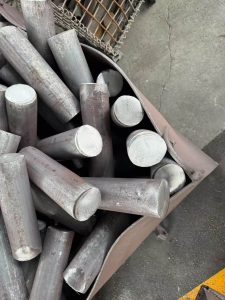forging small parts
Luoyang Forging can forge small parts for customers through die forging. The weight of small parts is generally between 0.2KG-70KG, and the size range is between 5-30 cm. Die forging can not only increase the hardness and toughness of small parts by changing the metal state, but also improve the precision of small parts. Forged small parts are mainly used in power equipment, petroleum equipment, shipbuilding equipment, and engineering equipment industries.

What equipment is needed to forge small parts?
Forging small parts requires a forging hammer or a forging machine because the weight is not very large. The forging hammer is generally around 70-300 tons, and the forging machine can complete the forging with 680 tons and 750 tons. For small forging parts with large weight, a forging machine of about 1,000 tons can be selected.
Secondly, there are some auxiliary equipment, such as shot blasting machines, which are used to deal with burrs or oxide scales on the blanks. Raw material heating equipment, after the raw materials are heated, it is easy to forge during forging.

Die Forging Process for Small Forgings
The die forging process of small forgings is the same as other forging processes, cutting-heating-forging-processing-heat treatment.
Key points of the process, heating of raw materials, carbon steel: 1100-1200℃ (initial forging) – 800℃ (final forging);
Secondly, in terms of mold design, forging molds are generally designed with H13 steel. Small forgings are mainly due to their high precision, and small parts of the mold require high-precision mold cavities (tolerance ±0.1mm). Good die forging design can save a lot of time for the subsequent forging process and improve the utilization rate of materials.

Material selection for small forgings
The material selection for small forgings is very wide, including carbon steel (such as AISI 1045), alloy steel (such as 4140), stainless steel or aluminum alloy, which can be selected according to strength, corrosion resistance or weight requirements.
Carbon steel and stainless steel are generally selected, such as 42CR. Some small forgings require heat treatment. After proper heat treatment, the hardness of 42Cr steel can reach different levels.
Hardness range of 42CR under different heat treatment processes
1. Oil medium quenching: hardness can reach above HRc551.
2. Water medium quenching: hardness can reach above HRc601.
3. Rockwell hardness test: hardness can reach 45-5HRC1.
4. Brinell hardness test: hardness range is 255~295 HB
Material forging should be selected according to customer needs. For example, if customers use it in the shipbuilding industry and the automotive parts industry, the material selection will be different. Shipbuilding industry generally uses AISI 1045 and ASTM A36, while automotive parts materials use AISI 1045, 4140, and 38MnVS6. We will recommend materials to customers based on their actual needs.

Why choose die forging to forge small forgings
First, the annual market purchase volume of small forged parts is very huge. Die forging can achieve mass production, and at least hundreds of thousands of pieces can be produced each year to meet market demand.
Second, die forging can meet the precision requirements of small forged parts. Die forging relies on closed dies, and the dimensional accuracy can reach IT8-IT10 level, and the surface roughness Ra 3.2-6.3μm, which reduces the amount of subsequent machining, and can also realize small forgings with complex structures.
Third, die forging can improve the quality of small forgings. Die forging makes the metal fibers distribute along the contour of the parts, improve fatigue strength and impact resistance (key for parts that bear alternating loads, such as crankshafts). Increase the toughness of parts.
